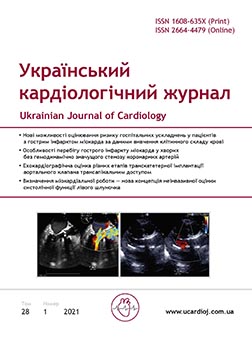Features of echocardiographic assessment on transcatheter aortic valve implantation multiple stages
Main Article Content
Abstract
The aim – to systematize information on key features of echocardiographic evaluation of transcatheter aortic valve implantation (TAVI) procedure stages and their effectiveness in cardiac surgery, in patients with severe aortic valve stenosis.
Materials and methods. We initiated a single-center clinical study to evaluate the XPand device and initial analysis of the primary results was performed. Patients met the inclusion criteria underwent a full range of examinations and TAVI procedures using the XPand device. The key parameters for echocardiographic examination in TAVI, which influence the formation of further procedure strategy, have been determined for the cardiac surgeon.
Results and discussion. Based on the determined echocardiographic parameters, we obtained the primary outcomes of TAVI XPand in patients (n=7), the result of implantation was good. Minimal paravalvular insufficiency absence was found in 71.5 % of patients and minimal insufficiency in 14,5 %. In one patient to moderate insufficiency was observed. There was a statistically significant improvement in the ejection fraction (p<0.05) and a decrease in the mean gradient at the aortic valve (p<0.01).
Conclusions. Echocardiographic parameters at all TAVI stages in patients over 75 years allow to control the implementation of the procedure and to improve the immediate post procedural outcome. The first experience of using the novel device for transcatheter implantation of the XPand aortic valve prosthesis confirms its effectiveness and safety in elderly patients with severe aortic stenosis.
Article Details
Keywords:
References
Baumgartner H., Hung J., Bermejo J. et al. Echocardiographic assessment of valve stenosis; EAE/ASE recommendations for clinical practice // J. Am. Soc. Echocardiogr.– 2009.– Vol. 22 (1).–P. 1–23. doi: https://doi.org/10.1016/j.echo.2008.11.029.
Baumgartner H., Hung J., Bermejo J. et al. Recommendations on the Echocardiographic Assessment of Aortic Valve Stenosis: A Focused Update from the European Association of Cardiovascular Imaging and the American Society of Echocardiography // Eur. Heart J. Cardiovasc. Imaging.– 2017.– Vol. 18 (3).– P. 254–275. doi: https://doi.org/10.1093/ehjci/jew335.
Brown J.M., O‘Brien S.M. ESC/EACTS Guidelines for the management of valvular heart disease // Eur. Heart J.– 2017.– Vol. 38 (36).– P. 2739–2791. doi: https://doi.org/10.1093/eurheartj/ehx391.
Holmes D.R., Mack M.J. Transcatheter valve therapy: a professional society overview from the American College of Cardiology Foundation and the Society of Thoracic Surgeons // Ann. Thorac. Surg.– 2011.– Vol. 92.– P. 380–389.
doi: https://doi.org/10.1016/j.athoracsur.2011.05.067.
Joint Task Force on the Management of Valvular Heart Disease of the European Society of Cardiology (ESC); European Association for Cardio-Thoracic Surgery (EACTS) // Eur. Heart J.– 2012.– Vol. 33.– P. 2451–2496.
Muraru D., Badano L.P., Vannan M. et al. Assessment of aortic valve complex by three-dimensional echocardiography: a framework for its effective application in clinical practice // Eur. Heart J. Cardiovasc. Imaging.– 2012.– Vol. 13.– P. 541–555. doi: https://doi.org/10.1093/ehjci/jes075.
Mylotte D., Martucci G., Piazza N. Patient selection for transcatheter aortic valve implantation: an interventional cardiology perspective // Ann. Cardiothorac. Surg.– 2012.– Vol. 1 (2).– P. 206–215. doi: https://doi.org/10.3978/j.issn.2225-319X.2012.06.08.
Onishi T., Sengoku K., Ichibori Y. et al. The role of echocardiography in transcatheter aortic valve implantation // Cardiovasc. Diagn. Ther.– 2018.– Vol. 8 (1).– P. 3–17. doi: https://doi.org/10.21037/cdt.2018.01.06.
Osnabrugge R.L., Kappetein A.P., Reynolds M.R., Cohen D.J. Cost-effectiveness of transcatheter valvular interventions: economic challenges // EuroIntervention.– 2013.– Vol. 9 (Suppl.).– P. S48–54. doi: https://doi.org/10.4244/EIJV9SSA10.
Pascual I., Carro A., Avanzas P. et al. Vascular approaches for transcatheter aortic valve implantation // J. Thorac. Dis.– 2017.– Vol. 9 (Suppl. 6).– P. S478–S487. doi: https://doi.org/10.21037/jtd.2017.05.73.
Pibarot P., Dumesnil J.G. Low-flow, low-gradient aortic stenosis with normal and depressed left ventricular ejection fraction // J. Am. Coll. Cardiol.– 2012.– Vol. 60.– P. 1845–1853. doi: https://doi.org/10.1016/j.jacc.2012.06.051.
Staubach S., Franke J., Gerckens U. et al. Impact of aortic valve calcification on the outcome of transcatheter aortic valve implantation: results from the prospective multicenter German TAVI registry // Catheter. Cardiovasc. Interv.– 2013.– Vol. 81.– P. 348–355. doi: https://doi.org/10.1002/ccd.24332.
Ye J., Cheung A., Lichtenstein S.V. et al. Transapical aortic valve implantation in humans // J. Thorac. Cardiovasc. Surg.– 2006.– Vol. 131.– P. 1194–1196. doi: https://doi.org/10.1016/j.jtcvs.2006.01.026.


